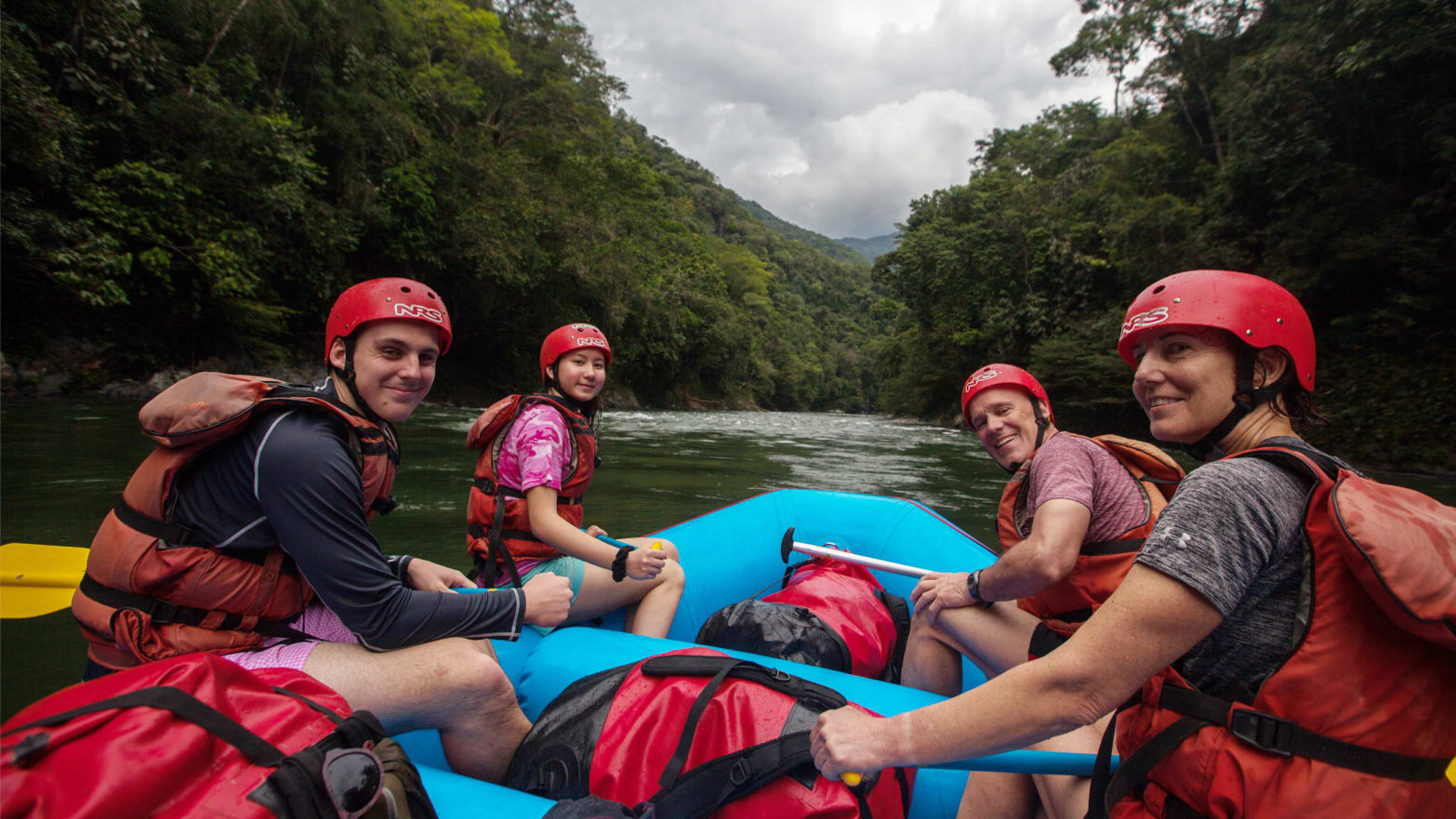The road to San Francisco rises steeply out of Medellin, just as all roads rise steeply out of Medellin, because Colombia’s second-largest city sits in a bowl at the base of the Andes mountains and because most of this country seems to lie either at the bottom of such a range or at the top of one.
I was packed into a van with a family from Chicago commandeered by French whitewater rafting bros, who differ only from American whitewater rafting bros in that they don’t make you want to knife a hole in their hulls. They’re nice guys, in other words, and they don’t seem afflicted by the kind of burnout that so often characterizes ski bums and surfers and other privileged adrenaline chasers who are bored with anything in life except whatever sport to which they’ve dedicated their entire existence. These guides’ level of stoke seemed genuine, untainted. That’s likely because they not only get to run one of the last wild rivers in Antioquia. They’re also trying to save it.
The river is a 55-kilometer tributary of the mighty Magdalena known as the Rio Samana, but also the Rio Verde, the verdant offshoot gathering up the water of a dozen small tributaries before it hits the 100-kilometer length of the Samana, a turgid body of water crackling through steep, wild canyon walls, its destination near a former hideout of Pablo Escobar. The Green River is accessible only by way of this winding van ride to San Francisco, a humble collection of streets halfway between Medellin and Bogota that’s still perfectly fine to navigate on horseback. Then, a stop to strap rafts and kayaks to the backs of mules, and a punishing but lush and forested hike down yet another of Colombia’s ubiquitous steep slopes to the put-in.
I have been a self-taught whitewater rafting guide for about a decade, fumbling and capsizing my way down a popular stretch of Oregon’s McKenzie River with a rented boat and a motley crew of stoned and drunk friends on as many weekends of our fleeting summers as I could rally enough of them to join me. No matter how hot it gets outside, the water is always brain-freeze cold. Depending on the water levels, we spend afternoons ping-ponging through rock gardens or careening in and out of giant, gushing bowls of raging whitewater, culminating at a Class IV rapid known as Marten’s that has claimed the lives of many an oarsman dumb enough to run it without a life jacket. Properly equipped, it’s a safe float.
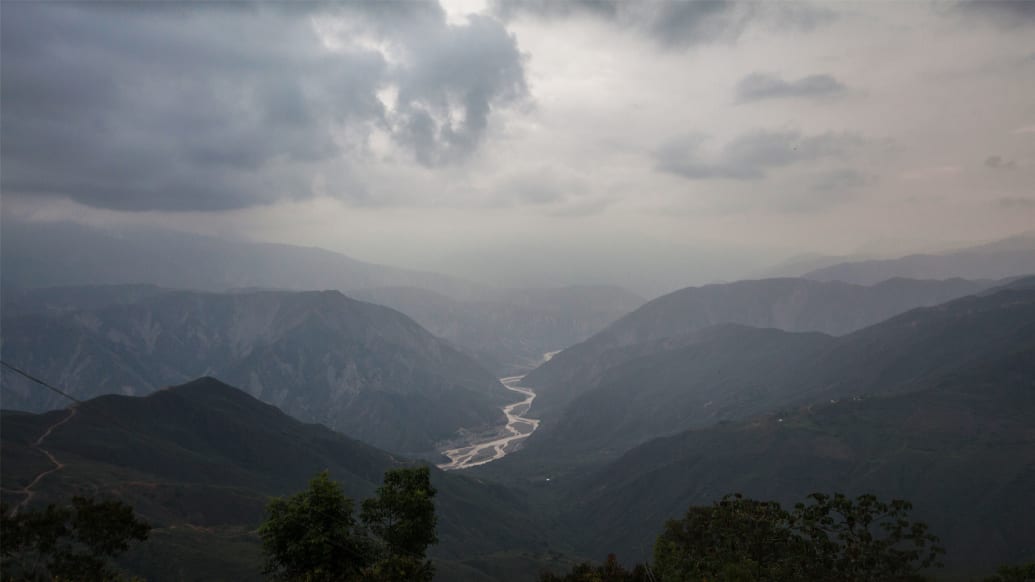
Winston Ross
The Samana, my refreshingly enthusiastic guides explained en route to San Francisco, is known in Colombia as the “jewel of the Magdalena,” a body of water unlike anything I’d ever traversed. It flows on the eastern side of the central cordillera of the Andes, and it once bisected the territories of warring factions in the country’s long-running three-way battle between guerrillas of the Revolutionary Armed Forces of Colombia, The National Liberation Army and a loose collection of militias recruited by the Colombian government to battle them both. This river was the front line, a barrier across which bullets flew regularly, and a conduit for the bodies of fallen soldiers and gangsters. The civil war, La Violencia, claimed 200,000 lives. The Samana was not, in other words, a safe place to go whitewater rafting.
Today, thanks to the peace treaty negotiated between these factions in November 2016, the only thing tourists need worry about on the Samana is mosquito bites. And drowning.
Our guides stopped only twice on the journey to San Francisco. Once, at my behest, to buy green coffee beans from a woman they’d spotted on the side of the road, spreading them out on a green plastic tarp to dry them in the sun. She sold me about four pounds of coffee for $8. The second stop was for flambres at a little roadside bar at an overlook with a view of the Samana River Valley basin, which spans more than 1,000 square miles. From this vantage point, we had a clear view of the forest-lined waterway below.
It was a long way down.
In San Francisco, Antioqueno caballeros on horseback trotted through narrow streets once surrounded by land mines. We loaded up on water and snacks and headed down a bumpy road, where our floppy-eared chariots awaited us. Without these patient burros, this trip would have been impossible, for there is no access to the Rio Verde by car, and no man strong enough to haul a 120-pound whitewater raft down a 2,000-foot descent into the wilderness.
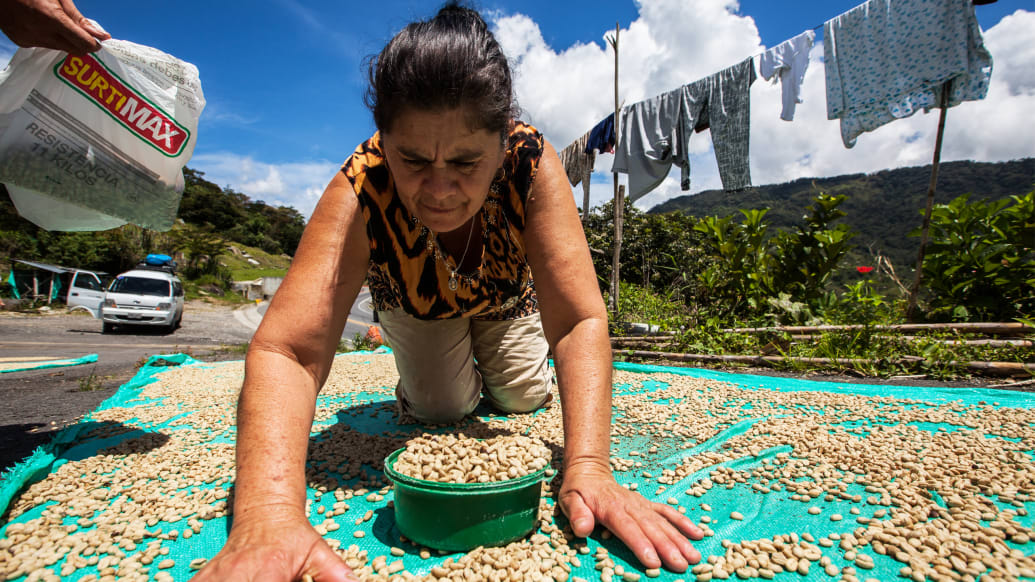
Winston Ross
Expedition Colombia was founded by Jules Domine, a French hydrologist. Domine didn’t join us on this trip because he was preparing for a peaceful protest in Narisses, of a development that could soon make expeditions like this one a thing of memory: the Porvenir II, a $800 million, 400-foot-tall hydroelectric dam that would flood 2,000 acres in the basin and occupy 27 kilometers of the Samana, generating 352 megawatts of electricity. The project would meet 3 percent of the country’s existing power needs.
The project is hailed by local government officials as a bringer of jobs, predictably, as progress. It is a symbol of the kind of economic development that is newly possible, thanks to the end of the long civil war. There’s some truth to that. Anticipated growth in post-conflict Colombia means a spike in demand for power, and villagers in these low-lying communities subsist on meager incomes generated by fishing and panning for gold. The construction phase of a new dam would mean an influx of 5,000 direct and indirect jobs and $1.4 million a year in royalties paid to the government, which is why the mayors of nearby cities have all lent support to the project, and Colombians are building makeshift wooden cambuches on the banks to join the census and stake claim to the cash they may earn if they’re forced to “relocate.” But the jobs that remain once the dam is built are estimated to number in the dozens, not the hundreds, and the residents who live here now must face the prospect of being forced to leave a home that only in the last few years had finally become safe to occupy.
“It could be said that the war kept the Samana safe,” wrote Carlos Gutierrez Torres, in an April 2017 editorial in the Colombian newspaper El Spectador. “The conflict allowed the conservation of some ecosystems, either because the armed actors imposed limits to the degradation of the environment, or because they appropriated these territories and nobody dared to step on them.”
Thus, Domines’ somewhat quixotic protest, an earnest but uphill attempt to save the Samana from a fate that would instantly transform its rushing waters into a lake. He and other activists have lobbied, marched and ultimately filed a lawsuit, and the gathering that followed our trip down the river would mark the largest collection of advocates for the river in anyone’s memory. Protesters floated from where our trip ended to the bridge above Narisses, where they formed a human chain of more than 500 people. Many of the 62 families in the basin depend directly on gold-panning and fishing for catfish, herring and the prized bocachico.
But before all that, we floated the Rio Verde, for what may be one of the last such expeditions ever. Something about the finite nature of this offering made it that much more special, if bittersweet. Imagine being one of the last to climb Mt. Everest, or hike the Swiss Alps. An adventure you’ll never be able to repeat is an adventure you’ll never forget.
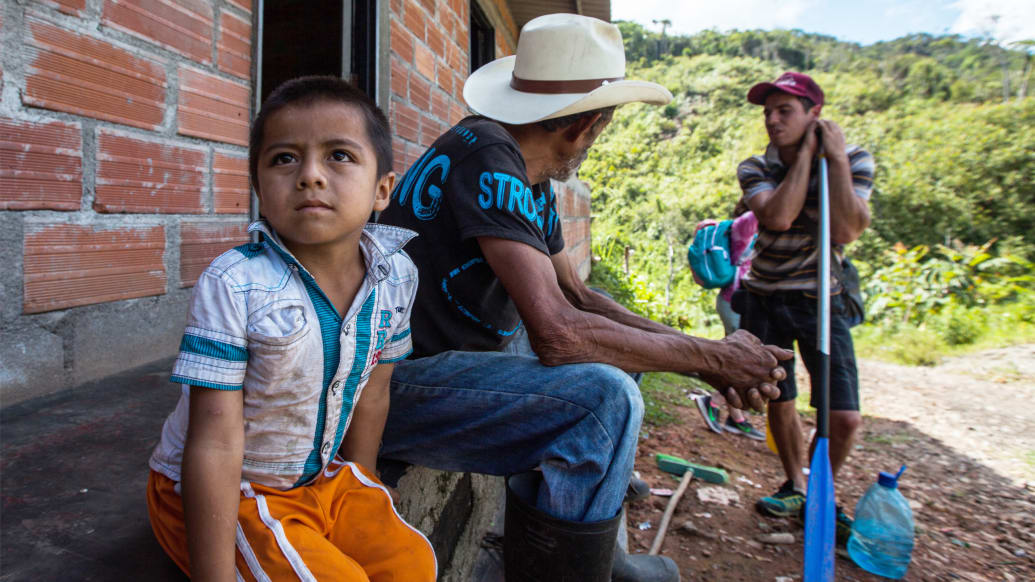
Winston Ross
The hike to the put-in was only tough because muddy descents test the kneecaps of certain (ahem) middle-aged men. Had we done this trek a year earlier, we’d have much bigger potential problems than a twisted ankle: the prospect of a kidnapping for ransom. At the put in, Jules and his fellow guides blew up the rafts as I surveyed the landscape: emerald green water gliding between tree-lined banks, toucans and blue and yellow Macaws calling out for mates across the divide, and… nothing else. No ostentatious riverfront palaces, no chainsaws ripping through Ceiba trees in the distance, no hunters blasting away at ducks in the blind. Just the blissful cacophony of the jungle.
There is no place I’d ever rather be than on a river. Any river. Especially as a guide, and especially as a city-dweller who has always struggled to quiet the din of thought, rumbling through my distractible mind. Rivers demand a focus that forbids ruminating on anything but finding a clean line. They provide a constantly changing landscape, one vista giving way to the next, forever.
Our first day on the Rio Verde didn’t include much in the way of whitewater. This is a calmer, prettier stretch of the Samana, an opportunity for passengers to swap stories. I learned that after the gathering in Narisses, Jules would head south for a month-long trek on the mighty Amazon river, a float never before undertaken in a single stretch. Jules has run rivers around the world. The Samana is his favorite, he says. The play spots in the whitewater sections are thrilling, the pace of life in San Francisco, where he lives, is chill.
After a couple of hours on the water, we arrived at a surprisingly well-established camp. A short climb up a steep bank led to a well-built structure fortified with guadua bamboo, nestled into the jungle. Our guides made dinner over a wood fire and drank a little Aguardiente. Domine, a world-class kayaker who has traversed more than 600 rivers in 15 countries, moved with his family from the French Alps to Alaska to explore the wilderness. He was the first to float the Samana in such a craft, and he did so in 2012, before the treaty but after the fighting had died down enough to make it a relatively safe excursion. Domine had watched many of his favorite rivers around the world become un-runnable due to dams, pollution, or other development. The company proposing the Samana dam, Celsia, was still in the permitting phase back then. Maybe, he thought, there’d be enough time to stop the project. So he moved to San Francisco and founded a non-profit, the Yumana Foundation, which sued the government in late 2016. It’s not often that your whitewater rafting guide is also an activist.
“This river used to be a divider,” Domine tells me. “Now, people are uniting in front of it.”
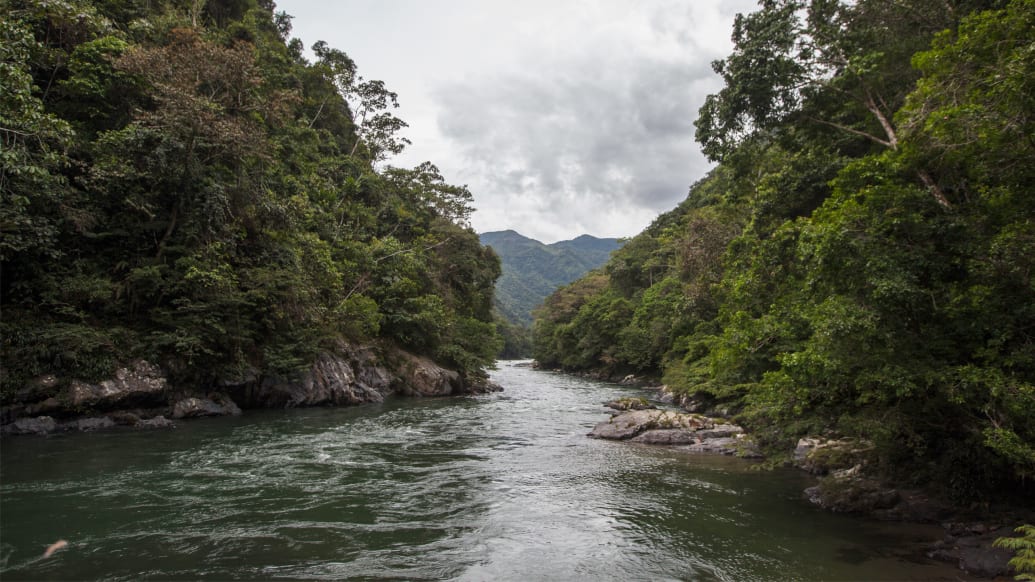
Winston Ross
At night, we climbed into hammocks strung from the guadua trees, and I did my best to sleep, despite one of my fellow passengers swinging into me at regular intervals. We awoke, and after a morning jungle hike towards the small town of Boqueron, we embarked to see the green river meet a brown one.
Even after the water gets muddy, the Samana is a pristine jaunt through a silver-blue rock canyon lined with karst cliffs carved by millions of years of calcite deposits, and a never-ending stretch of rheophytes, plants that grow along the margins of swift water currents.
.
Last year Domine marshaled support for his quest by recruiting a Colombian biologist, Rodrigo Bernal, to survey the plants that would be submerged by a dam-inspired lake. Bernal found an endemic species of palm, the Aiphanes argos, which even if transplanted safely to other areas in a mitigation effort by the mine would still probably go extinct if the Samana is flooded. On a later trip, he found a total of nine endemic rheophytes, all of which he declared “critically endangered.”
“How can there be peace, asked indigenous tribe leader Mamo Camillo at last year’s protest, “if peace only means that the two sides unite to lead a war against nature?”
That day’s run lasted about four hours, with a stop for lunch and a swim from a boulder wedged into a tributary creek. The only real challenging rapid, Meleficio, is a class IV beast a few minutes before the takeout at the tiny village of Narisses, where Pablo Escobar once evaded government capture. One of our guides traveled ahead in a kayak to scout it, because there are three different lines that vary with water levels, which can change within minutes due to overnight rains. The walls of the canyon are so steep that even a short shower can cause a several inch rise in the water. On this day, we chose the middle of the froth, bouncing happily through undulating waves and high-fiving our kayak paddles at the end. We loaded our gear up a dirt road and jumped back in the van to Medellin.
That was probably the last time I’ll go whitewater rafting in Colombia, with so much of the world to see, but since he started it in 2012, Domine’s company has brought dozens of paddlers to this gem in the wilderness. He hopes, and I do too, that if enough people see it, they’ll help him save it. Domine’s case is getting stronger by the day, thanks to a catastrophe playing out at Colombia’s fifth-largest dam, the Hidrituango. Its tunnels have blocked, causing flooding upstream and leading to the evacuation of thousands of villagers in towns below the dam. The dam is now at half-capacity, according to an article in The Bogota Post, and it may collapse. “We have proof,” Domine said Wednesday, “that these dams are a mistake. They’re built irresponsibly, and they generate more problems than benefits.” If the dam fails, the loss of hydropower will surely ramp up pressure for a new source. But it will also add fuel to the opposition.

